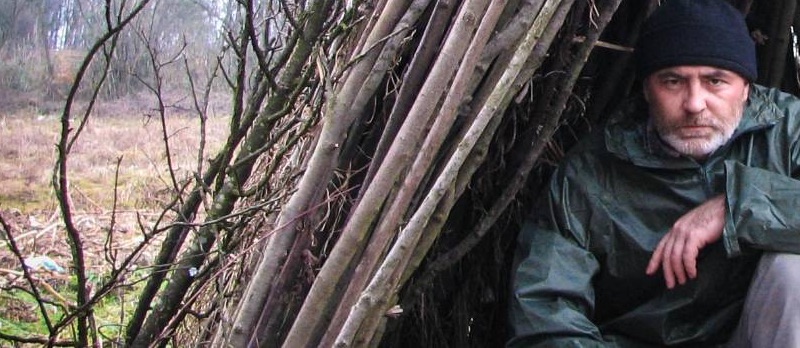Get the weekly SPARTANAT newsletter.
Your bonus: the free E-Book from SPARTANAT.

Rainer Salzger: "Tracing saves lives"
Each of us leaves traces. And few can read them. One who is knowledgeable in reading is a tracker and can decipher information from the ground and vegetation about what has happened here and left its traces. Survival trainer Rainer Salzger has summarized the knowledge in "Military Tracking" in his excellent book (HERE our review of it). We from SPARTANAT wanted to know from him why military tracking is so important.
SPARTANAT: You have written a very good book about "Military Tracking." What is the military value of these ancient techniques?
Rainer Salzger: First of all, thank you for the opportunity to present this book to you. Is it a very good book? I think it is the best one you can find on this topic in the German-speaking area - probably because it is the only one - as far as I know. Let's see how long it lasts.
Tracking is an ancient human ability, absolutely right. Various modern armies have, albeit hesitantly, answered the question of its value in a highly technological military environment in recent years: they now see it as an additional means to increase or improve self-protection (Force Protection) in operational areas under the aspect of the IED threat. Techniques of tracking are taught in specific Ground Sign Awareness (GSA) courses. It has been shown that a soldier's ability to recognize an improvised explosive device (IED) can be increased by up to 80%. Attention is paid to the smallest details, such as a broken branch or when grass shows a different color.
In a nutshell: tracking techniques save lives, military tracking could hardly be more valuable. But this is just one facet that makes up the military value of Military Tracking. More about this can be found in the book.
![]() SPARTANAT: What are the three fundamental tips for recognizing tracks?
SPARTANAT: What are the three fundamental tips for recognizing tracks?
Rainer Salzger: First, one must be aware of the following fact: a walking person leaves signs approximately every 0.45-0.50 meters or more than 2000 times per kilometer! A beginner can see many relevant signs, but will mostly not recognize them as such. That is precisely the point: you must know what you are looking for!
Therefore, my tip number 1: Familiarize yourself with the basic tracks and signs that a wanted person may leave behind. These are listed photographically in the book.
Secondly: Tracking is a highly visual skill, so light plays an important role. Tracks are easier to recognize when the sun is at a low angle. So early in the morning or late in the afternoon. Low angles cause longer shadows, which highlight the details of each impression on the ground.
Last but not least tip number 3: Regularly change your perspective during the search. Above all: look down, forward, up, and backward.
SPARTANAT: Not everyone wants to be found. What are the most efficient techniques to erase your own tracks?
Rainer Salzger: This question had to come up. But the answer is relatively simple. There are countless techniques to escape a pursuer, each of which is effective in a specific situation, depending on the environmental conditions. Unfortunately, there are not one or two techniques that cover every situation!. Here, you cannot avoid acquiring all the described anti-tracker techniques.
SPARTANAT: How long does it take to learn to read tracks until you master it at least to some extent? Is there a training plan?
Rainer Salzger: One thing is clear, tracking is not learned overnight. 60 hours of basic training are the norm for beginners. A good tracker is one after 6 to 10 years, the best trackers have at least 20 years of experience. Moreover, tracking is a skill that must be maintained. As a tracker, one is constantly practicing, practicing, practicing.
Training plan? For military trackers, certainly. In the civilian sector, it is mainly Search and Rescue units that train mantrackers according to a plan. I cannot explain in detail what military training plans for tactical combat trackers look like. However, an example of a possible beginner training is mentioned in the book.
SPARTANAT: How did you come to learn tracking yourself?
Rainer Salzger: This is a question whose answer would inevitably touch on sensitive military areas. No comment.
RAINER "SNAKE" SALZGER (43), after a trade school and training as a GWZ installer, called up for military service. Meanwhile, for over 20 years a professional soldier in the Austrian Armed Forces. Due to his ability to approach his opponents like a snake, he is given the nickname "SNAKE." Acquired numerous qualifications, including: close combat instructor, shooting instructor, ordnance disposal expert, high mountain training. Survival enthusiast since his youth. Literature studies, the practical implementation of countless survival techniques, and survival courses in the Amazon rainforest have made him a survival expert. In numerous books that he has written over the years, he shares his knowledge acquired over the years with all interested readers. TV stations have brought him on board for their productions, not least because of this: in 2013 as a survival instructor for LYONESS TV, in 2012 as a survival instructor on the TV format "NEWTON" of the Austrian Broadcasting Corporation (ORF), 2010 PULS 4 for the TV format "Austria's new-footballstar." Personal motto: "Be prepared - Fortune favors those who are prepared."
SPARTANAT is the online magazine for Military News, Tactical Life, Gear & Reviews.
Send us your news: [email protected]
Ad
similar
Get the weekly SPARTANAT newsletter.
Your bonus: the free E-Book from SPARTANAT.


